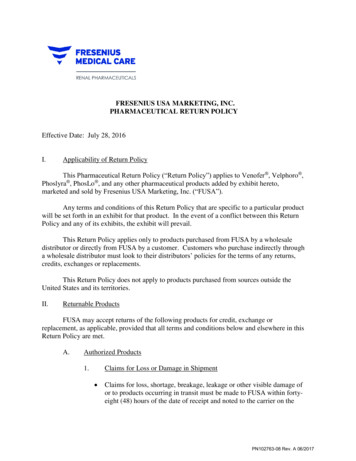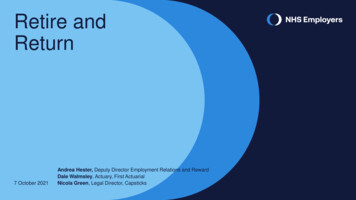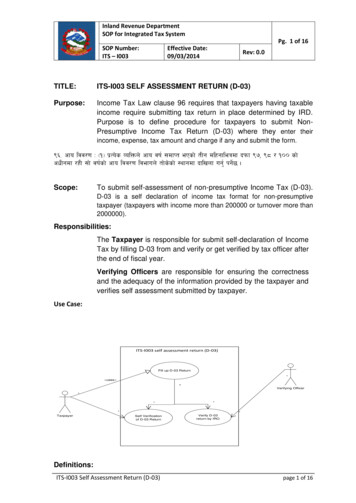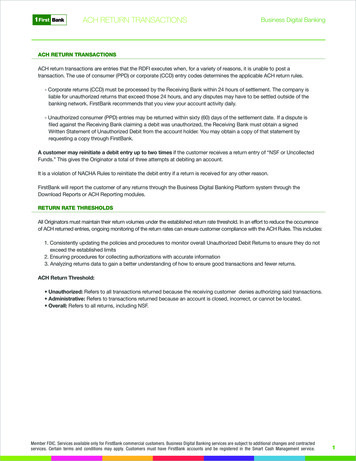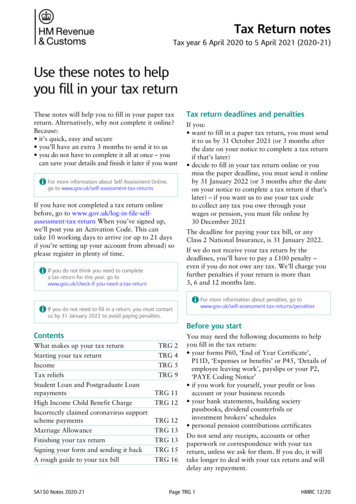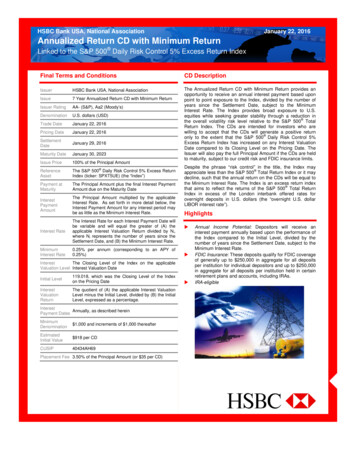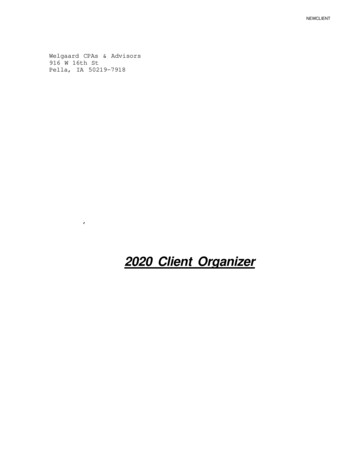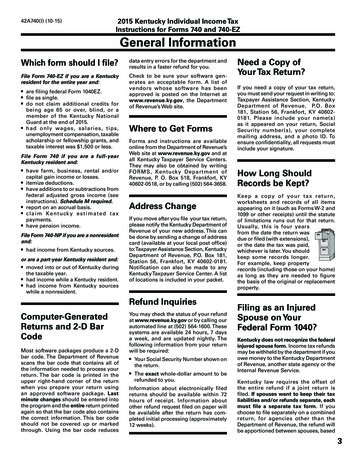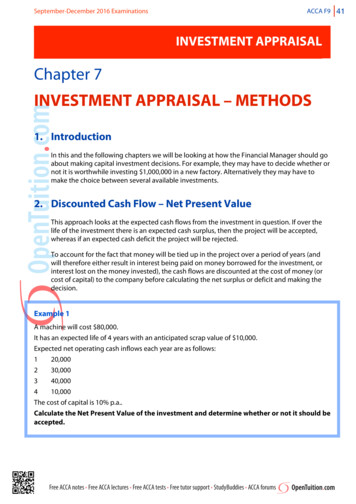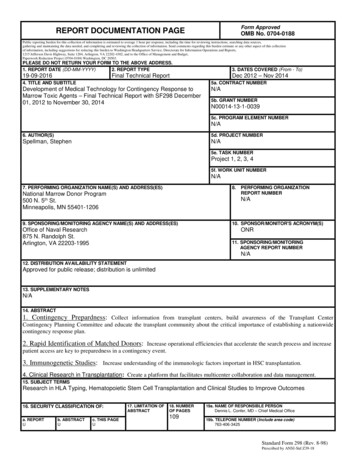
Transcription
Form ApprovedREPORT DOCUMENTATION PAGEOMB No. 0704-0188Public reporting burden for this collection of information is estimated to average 1 hour per response, including the time for reviewing instructions, searching data sources,gathering and maintaining the data needed, and completing and reviewing the collection of information. Send comments regarding this burden estimate or any other aspect of this collectionof information, including suggestions for reducing this burden to Washington Headquarters Service, Directorate for Information Operations and Reports,1215 Jefferson Davis Highway, Suite 1204, Arlington, VA 22202-4302, and to the Office of Management and Budget,Paperwork Reduction Project (0704-0188) Washington, DC 20503.PLEASE DO NOT RETURN YOUR FORM TO THE ABOVE ADDRESS.1. REPORT DATE (DD-MM-YYYY)2. REPORT TYPE19-09-20163. DATES COVERED (From - To)Final Technical ReportDec 2012 – Nov 20144. TITLE AND SUBTITLE5a. CONTRACT NUMBERDevelopment of Medical Technology for Contingency Response toMarrow Toxic Agents – Final Technical Report with SF298 December01, 2012 to November 30, 2014N/A5b. GRANT NUMBERN00014-13-1-00395c. PROGRAM ELEMENT NUMBERN/A6. AUTHOR(S)5d. PROJECT NUMBERSpellman, StephenN/A5e. TASK NUMBERProject 1, 2, 3, 45f. WORK UNIT NUMBERN/A7. PERFORMING ORGANIZATION NAME(S) AND ADDRESS(ES)8.National Marrow Donor Program500 N. 5th St.Minneapolis, MN 55401-1206PERFORMING ORGANIZATIONREPORT NUMBERN/A9. SPONSORING/MONITORING AGENCY NAME(S) AND ADDRESS(ES)Office of Naval Research875 N. Randolph St.Arlington, VA 22203-199510. SPONSOR/MONITOR'S ACRONYM(S)ONR11. SPONSORING/MONITORINGAGENCY REPORT NUMBERN/A12. DISTRIBUTION AVAILABILITY STATEMENTApproved for public release; distribution is unlimited13. SUPPLEMENTARY NOTESN/A14. ABSTRACT1. Contingency Prepardness: Collect information from transplant centers, build awareness of the Transplant CenterContingency Planning Committee and educate the transplant community about the critical importance of establishing a nationwidecontingency response plan.2. Rapid Identification of Matched Donors: Increase operational efficiencies that accelerate the search process and increasepatient access are key to preparedness in a contingency event.3. Immunogenetic Studies: Increase understanding of the immunologic factors important in HSC transplantation.4. Clinical Research in Transplantation: Create a platform that facilitates multicenter collaboration and data management.15. SUBJECT TERMSResearch in HLA Typing, Hematopoietic Stem Cell Transplantation and Clinical Studies to Improve Outcomes16. SECURITY CLASSIFICATION OF:a. REPORTUb. ABSTRACTUc. THIS PAGEU17. LIMITATION OFABSTRACT18. NUMBEROF PAGES10919a. NAME OF RESPONSIBLE PERSONDennis L. Confer, MD – Chief Medical Office19b. TELEPONE NUMBER (Include area code)763-406-3425Standard Form 298 (Rev. 8-98)Prescribed by ANSI-Std Z39-18
National Marrow Donor Program N00014-13-1-0039HLA Typing for Bone Marrow TransplantationFINAL REPORTDecember 1, 2012 – November 30, 2014
National Marrow Donor Program N00014-13-1-0039HLA Typing for Bone Marrow TransplantationFINAL REPORTDecember 1, 2012 – November 30, .3.3IIB.3.4IIB.3.5IIB.3.6IIB.4.1IIB ment AAttachment BTABLE OF CONTENTSDESCRIPTIONAcronym ListExecutive SummaryContingency PreparednessSecure Interest of Transplant PhysiciansGCSF in Radiation ExposurePatient Assessment GuidelinesContingency Response NetworkDevelop and Test Standard Operating ProceduresI.S. Business Continuity Planning / Disaster RecoveryOperational Continuity PlanningRapid Identification of Matched DonorsIncrease Registry DiversityEvaluate HLA-DRB1 High Resolution TypingEvaluate HLA-C Typing of DonorsEvaluate Buccal SwabsEnhancing HLA Data for Selected DonorsMaintain a Quality Control ProgramCollection of Primary DataValidation of Logic of Primary DataReinterpretation of Primary DataGenotype Lists & Matching AlgorithmPhase I of EM Haplotype LogicEnhancement of EM AlgorithmOptimal Registry Size AnalysisTarget Under-represented PhenotypesBioinformatics Web SiteMaximize software using consultant dataExpand Network CommunicationsCentral Contingency ManagementImmunogenetic StudiesDonor Recipient Pair ProjectAnalysis of non-HLA LociClinical Research in TransplantationObservational Research, Clinical Trials and NIH Transplant CenterResearch with NMDP DonorsExpand Immunobiology ResearchReferencesListing of Published Manuscripts and Abstracts associated with this GrantTable of 05052535455565759596363657171818185881
National Marrow Donor Program N00014-13-1-0039HLA Typing for Bone Marrow TransplantationFINAL REPORTDecember 1, 2012 – November 30, 2014ACRONYM LISTAABBAAFAAAR/IPABAABDABMTRACAFAAFBAFRRIAGNIS QPARC CB-LCLsB2BBAABARDAAmerican Association of Blood BanksAfrican American (NMDP race code)After Action Review/Improvement PlanAmerican Burn AssociationAntigen Binding DomainAutologous Blood and Marrow Transplant RegistryApheresis CenterAfrican AmericanAfricanArmed Forces Radiobiology Research InstituteA Growable Network Information SystemAmerican Hospital AssociationAncestry Informative MarkersSouth AsianAmerican Indian South or CentralAlaska Native or AleutAldehyde DehydrogenaseAldehyde Dehydrogenase brightNorth American IndianAcute Myelogenous LeukemiaAmerican IndianAmerican National Standards InstituteAsian Pacific IslanderAncestry Questionnaire ProjectArcGIS is a brand name: GIS Geographical Information SystemThe American Recovery and Reinvestment Act of 2009Acute Radiation Syndrome (also known as Acute Radiation Sickness)Antigen Recognition SiteAmerican Society for Blood and Marrow TransplantationAustralian and South East Asian Tissue Typing AssociationAmerican Society for HistocompatibilityAmerican Society of Human GeneticsAmerican Society for Histocompatibility and ImmunogeneticsAsian AmericanAssistant Secretary for Preparedness and ResponseAssociation of State and Territorial Health OfficialsArea Under CurveB-Lymphocytic Cell LinesBusiness to BusinessBroad Agency AnnouncementBiomedical Advanced Research and Development AuthorityAcronym List2
National Marrow Donor Program N00014-13-1-0039HLA Typing for Bone Marrow TransplantationFINAL REPORTDecember 1, 2012 – November 30, 2014BBMTBCPBCPeXBGIBISCBMBMCCBMDWBMTBMT ACDCCFUCDECDISCCEMCEOBiology of Blood and Marrow TransplantationBusiness Continuity PlanningBusiness Continuity Plan ExerciseBeijing Genome InstituteBioinformatics Integration Support ContractBone MarrowBone Marrow Coordinating CenterBone Marrow Donors WorldwideBone Marrow Transplant/TransplantationBlood and Marrow Transplant - Clinical Trials NetworkBusiness Objects Data IntegratorBioinformatics Research Advisory Ginger GroupBiomedical Research Integrated Domain GroupBasic Radiation TrainingNIH/NCI Cancer Biomedical Informatics GridCancer Data Standards RepositoryCertification and AccreditationCollege of American PathologistsBlack CaribbeanCaribbean HispanicCaribbean IndianComputer Assisted Telephone InterviewingCaucasianCertification and AccreditationCord BloodCord Blood Advisory GroupCenter for Biomedical Informatics and Information TechnologyCanadian Blood and Marrow Transplant GroupCord Blood BankCongressional Black CaucusCanadian Blood ServiceCord Blood TransplantationCord Blood UnitCollection CenterContinuity of Care DocumentClinical Document ArchitectureCenters for Disease ControlColony Forming UnitCommon Data ElementsClinical Data Interchange Standards ConsortiumCertified Emergency ManagerChief Executive OfficerAcronym List3
National Marrow Donor Program N00014-13-1-0039HLA Typing for Bone Marrow TransplantationFINAL REPORTDecember 1, 2012 – November 30, 2014CFOCEPCFUCG-WGcGyCHORICHOPCHSCHTCCIBMTR SHDCChief Financial OfficerCollect Eject ProtectColony Forming UnitClinical Genomics Work GroupCentiGreyChildren’s Hospital of Oakland Research InstituteThe Children’s Hospital of PhiladelphiaCertified Histocompatibility SpecialistCertified Hematopoeitic Transplant CoordinatorCenter for International Blood & Marrow Transplant ResearchChief Information OfficerCIBMTR Information TechnologyClinical Laboratory Improvement AmendmentCenters for Medical Countermeasures Against RadiationChina Marrow Donor ProgramContinuing Medical EducationCommunity Matching FundsChronic Myelogenous LeukemiaChief Medical OfficerCenter for Medicare and Medicaid ServicesCytomegalovirusChildren’s Oncology GroupContinuous Process ImprovementCross Reactive GroupsCase Report FormsCIBMTR Recipient IDComputerized Repository Inventory SystemChief Recruitment OfficerColony Stimulating FactorsChief Strategy OfficerCenter Support ServicesCustom Search SupportConfirmatory TestingClinical Trial ApplicationCytotoxic T Lymphocyte PrecursorClinical Trial Management SystemCisco Unified Personal CommunicatorCo-efficient of VariationsCommon Well DocumentedDivision of Allergy, Immunology, and TransplantationData Standards HackathonDonor CenterAcronym List4
National Marrow Donor Program N00014-13-1-0039HLA Typing for Bone Marrow TransplantationFINAL REPORTDecember 1, 2012 – November 30, FILIIFLOCKDefense Contract Audit AgencyDana-Farber Cancer InstituteDepartment of Health and Human ServicesDo It YourselfDeutsche nucleic AcidDepartment of DefenseDepartment of EnergyData QualityDisaster RecoveryDonor/RecipientDonor Related Pair ProjectDonor specific anti-HLA antibodyData Safety Monitoring BoardDraft Standard for Trial UseDigital Video DiscEuropean Group for Blood and Marrow TransplantationEthics CommitteeEmergency DepartmentElectronic Data CaptureEuropean Federation for ImmunogeneticsElectronic Health RecordEnzyme-linked Immunosorbant AssayEnzyme-linked Immunosorbent SpotExpectation MaximizationEuropean Marrow Donor Information SystemElectronic Medical RecordsEmergency Notification SystemEnvironment Remote Sensing InstituteEnvironmental Systems Research InstituteEuropean AmericanEntrez Programming UtilitiesFluorescent Activated Cell SortingFederal Bureau of InvestigationFood and Drug AdministrationFund Drive RequestFrance Greffe de MoelleFred Hutchinson Cancer Research CenterFast Healthcare Interoperability ResourcesFilipinoFlow Cytometry Analysis ComponentAcronym List5
National Marrow Donor Program N00014-13-1-0039HLA Typing for Bone Marrow TransplantationFINAL REPORTDecember 1, 2012 – November 30, RGUIGVHDGWASGyHARPsHAWIHBCUHCHCS SRHTMLHWEIBMDRIBMTRFormsNetFormsNet3Fixation IndexFederal-wide AssuranceFiscal YearGovernment Emergency Telecommunications ServiceGranulocyte-Colony Stimulating Factor (also known as filgrastim)Group (HLA)-DR GenericGovernment Emergency Telecommunication ServiceGeographic Information SystemGenotype ListGranulocyte Macrophage Colony Stimulating FactorGeneral ServicesGenetic Testing RegistryGraphical User InterfaceGraft vs. Host DiseaseGenome Wide Association StudiesGray-measure of dose of irradiationHLA Ambiguity Resolution PrimersHawaiian or other Pacific Islander UnspecifiedHistorical Black Colleges and UniversityHematopoietic CellHealth Care StandardHematopoietic Cell TransplantationHospital Emergency Preparedness ProgramHealth History QuestionnaireHealth and Human ServicesHLA Information Exchange Data Format StandardsHealth Insurance Portability and Accountability ActHispanicHuman Immunodeficiency VirusHuman Leukocyte AntigenHistoimmunogenetics Mark-up LanguageHigh ResolutionHealth Resources and Services AdministrationHematopoietic Stem CellHematopoietic Stem Cell TransplantHealth Services ResearchHyperText Markup LanguageHardy-Weinberg EquilibriumItalian Bone Marrow Donor RegistryInternational Bone Marrow Transplant RegistryAcronym List6
National Marrow Donor Program N00014-13-1-0039HLA Typing for Bone Marrow TransplantationFINAL REPORTDecember 1, 2012 – November 30, MDSMENAFCmHAgMHCImmunobiology Working CommitteeInternational Consortium for Research on Health Effects of RadiationIdentificationImmunogenetics Data Analysis Working GroupInfectious Disease MarkersIntegrated Data StoreImmunoglobulinInternational Histocompatibility and Immunogenetics WorkshopInternational Histocompatibility Work ShopInternational Histocompatibility Working GroupImmunobiology Integration DatabaseInternational Immunomics SocietyImMunoGeneTicsInformation Management StrategyImmunology Database and Analysis PortalInvestigational New DrugImprovised Nuclear DeviceImmunobiology Project ResultsInstitutional Review BoardInformation ServicesInternational Organization for StandardizationInformation TechnologyJapaneseJoint Commission of Healthcare OrganizationsJoint Commission on Accreditation of Healthcare OrganizationsKiller Immunoglobulin-like ReceptorKoreanLinkage DisequilibriumLow Expression AllelesLife Sciences Strategy GroupLymphotoxin AlphaMillionMatrix-Assisted Laser Desorption/Ionization – Time Of FlightMasters of Biological ScienceMedical College of WisconsinMedical DoctorMD Anderson Cancer CenterModel Driven Health ToolsMyelodysplastic SyndromeMidEast/North Coast of AfricaMinor Histocompatibility AntigenMajor Histocompatibility ComplexAcronym List7
National Marrow Donor Program N00014-13-1-0039HLA Typing for Bone Marrow TransplantationFINAL REPORTDecember 1, 2012 – November 30, GSNHLBINIAIDNIHNIMANIMSNKNLNLENLMNMDP NNSANRPNSTNYCOBOB/GYNOCPMHC Class I-Like Molecule, Chain AMHC Class I-Like Molecule, Chain BMinimal Information for Reporting Immunogenomic NGS GenotypingMilwaukeeMixed Lymphocyte CultureMixed loss RatioMemorandum of UnderstandingMinimal Residual DiseaseMemorial Sloan-Kettering Cancer CenterMinneapolisMexican or ChicanoMatched Unrelated DonorNuclear Accident CommitteeNational Association of County and City Health OfficialsNative AmericanNorth AmericanNational Alliance for Radiation ReadinessNational Center for Biotechnology InformationNational Conference of Black MayorsChineseNational Cancer InstituteNational Disaster Medical SystemNew England Center for Emergency PreparednessN-locus Expectation-Maximization using Oligonucleotide typing dataNext Generation SequencingNational Heart Lung and Blood InstituteNational Institute of Allergy and Infectious DiseasesNational Institutes of HealthNon-inherited maternal antigenNational Incident Management SystemNatural KillerNetherlandsNational Level ExerciseNational Library of MedicineNational Marrow Donor ProgramNational Nuclear Security AdministrationNational Response PlanNon-myeloablative Allogeneic Stem Cell TransplantationNew York CityObstetricianObstetrics & GynecologyOperational Continuity PlanningAcronym List8
National Marrow Donor Program N00014-13-1-0039HLA Typing for Bone Marrow TransplantationFINAL REPORTDecember 1, 2012 – November 30, PSAPTQAMSQARMQCQRR&DRCCRCIRCI BMTRD RT-PCRSAASAPSBTSCAHISOptical Character Recognition/Intelligent Character RecognitionOffice of Human Research ProtectionsOffice of Information TechnologyOffice of Management and BudgetOffice of Naval ResearchOffice of Patient AdvocacyPeer-to-PeerPhysicians AssistantPeripheral Blood Mononuclear CellsPeripheral Blood Stem CellPolymerase Chain ReactionPrinciple InvestigatorProcedures of InteractionPsudopatientPublic Service AnnouncementProficiency TestingQuality Assurance Membership ServicesQuality Assurance and Risk ManagementQuality controlQuick ResponseResearch and DevelopmentRenal Cell CarcinomaResource for Clinical InvestigationsResource for Clinical Investigations in Blood and Marrow TransplantationRelated Donor SafetyRadiation Emergency Assistance Center/Training SiteSpanish Bone Marrow Donor RegistryRadiation Event Medical ManagementRadiation Emergency Medical Preparedness and AssistanceRepresentational State TransferRequest for ApplicationRequest for ProposalRequest for QuotationRecruitment GroupRhesusRadiation Injury Treatment NetworkReceiver Operating CharacteristicsReverse Transcriptase-Polymerase Chain ReactionSevere Aplastic AnemiaSingle Amino-Acid PolymorphismsSequence Based TypingSouth/Central American HispanicAcronym List9
National Marrow Donor Program N00014-13-1-0039HLA Typing for Bone Marrow TransplantationFINAL REPORTDecember 1, 2012 – November 30, SLWSNPSNSSOASOPSQLSRASRBSRGSSASSOSSPSSOPSSRSSTAR Black South or Central AmericaSickle Cell DiseaseSoutheast AsianStem Cell TransplantationStem Cell Therapeutics Outcome DatabasePage 10Sequence Feature Variant TypeSample GroupSynthetic Haplotype FrequencySelf Identified Race and EthnicitySt. Louis Cord Blood BankSTAR Link WebSingle Nucleotide PolymorphismStrategic National StockpileService Oriented ArchitectureStandard Operating ProcedureStructured Query LanguageSequence Read ArchiveSurvey Research GroupSurvey Research GroupSearch Strategy AdviceSequence Specific OligonucleotidesSequence Specific PrimersSequence Specific Oligonucleotide ProbesSample Storage Research StudySearch, Tracking and RegistrySupport Vector MachineSouthwest Oncology GroupTotal Body IrradiationTransplant CenterT-cell EpitopeTransplant Essential DataTotal Nucleated CellTotal Nucleated Cell CountTransplant Related MortalityTransportation Security AgencyText TelephoneUmbilical Cord BloodUmbilical Cord Blood TransplantUniversity of California – San FranciscoUser InterfaceUnified Modeling LanguageAcronym List10
National Marrow Donor Program N00014-13-1-0039HLA Typing for Bone Marrow TransplantationFINAL REPORTDecember 1, 2012 – November 30, 2014UNKURDUSUSIDUSIDNetUSBVCFVIETVPVPNWBMTWCWebEOC WGAWHWHOWMDAWUXMLZKRDUnkownUnrelated Registry DonorUnited StatesUnique System IdentifierUS Immunodeficiencies NetworkUniversal Serial BusVariant Cell FormatVietnameseVice PresidentVirtual Private NetworkWorldwide Network for Bone Marrow TransplantationWorking CommitteesWeb-based Emergency Operations CenterWhole Genome AmplificationWhiteWorld Health OrganizationWorld Marrow Donor AssociationWork-upExtensible Markup LanguageZertrales Knochenmarkspender – Register für die Bundesrepublik DeutchlandAcronym List11
National Marrow Donor Program N00014-13-1-0039HLA Typing for Bone Marrow TransplantationFINAL REPORTDecember 1, 2012 – November 30, 2014Executive SummaryIn 1986, Congress appropriated funds to begin development of the National Bone Marrow DonorRegistry. Today, 28 years later, the National Marrow Donor Program (NMDP), as the contractor forthe Registry, has built a racially diverse donor registry of 12 million donors, facilitated more than65,000 hematopoietic stem cell transplants, developed comprehensive research programs to improvepost-transplant outcomes, and established a network of transplant centers (TCs) capable of treatingcasualties resulting from military or terrorist actions, as well as patients suffering from leukemia,aplastic anemia, and other life-threatening diseases.Contingency Preparedness PlanningThis grant funded the continued development of the Radiation Injury Treatment Network (RITN).The RITN provides comprehensive evaluation and treatment for victims of radiation exposure or othermarrow toxic injuries from exposure to chemicals such as mustard agent. Many of the casualties withradiation injury will be salvageable, but require specialized supportive care to recover. Recognizingthis, the NMDP, US Navy and American Society for Blood and Marrow Transplantation (ASBMT)collaboratively developed RITN, which is comprised of medical centers with expertise in themanagement of bone marrow failure, stem cell donor centers and umbilical cord blood banks acrossthe US.The goals of RITN are:1. Develop treatment guidelines for managing hematologic toxicity among victims of radiationexposure2. Educate health care professionals about pertinent aspects of radiation exposure management3. Help coordinate the medical response to radiation events4. Provide comprehensive evaluation and treatment for victims at participating centersDuring the project period, RITN expanded to 55 transplant centers (up from 53), 6 donor centers and 7cord blood banks. RITN educated and trained medical and support staff across the nation including a 3day workshop on the mitigation and treatment of radiation damage and performed a fullscale nuclearevent exercise. Finally, RITN was made a member of the National Alliance for Radiation Readiness(NARR) a public-private partnership formed to improve radiological/nuclear disaster preparedness.The NMDP’s organizational resiliency program further improved the NMDP’s ability to weatherdevastating operational disruptions.Executive Summary12
National Marrow Donor Program N00014-13-1-0039HLA Typing for Bone Marrow TransplantationFINAL REPORTDecember 1, 2012 – November 30, 2014Rapid Identification of Matched DonorsDonor Recruitment TypingPublished research data have clearly defined the relationship between Human Leukocyte Antigen(HLA) matching and optimal patient outcomes following unrelated adult donor transplantation.Continually working to increase the genetic diversity of the Registry helps to ensure that morepatients will be able to locate a suitably matched stem cell product for a transplant.NMDP donor centers (including DoD) and recruitment groups added 205,607 minority race and191,977 Caucasian donors, for a total of 397,584 U.S. donors added to the Registry. DuringNMDP’s 2013 Fiscal Year (10/01/12-09/30/13) grant funds supported the HLA typing of 93,790 ofthis culturally diverse group of new donors, including 18,813 minority donors. All donors weretyped for a minimum of HLA-A, B, and DRB1.Evaluation of the Suitability of Buccal Swabs continued along 3 lines of investigation: Results from the 5-year Sample Storage Research Study were shared with the scientificcommunity as an oral abstract presentation at the November 2013 ASHI Annual Meeting andawarded the Best Stem Cell Case Study.Frozen buccal swab sample storage studies were initiated. Storing buccal swabs in a frozenstate has been shown by others to preserve DNA integrity for SBT for longer periods thancontrolled room temperature storage. A controlled storage study was initiated to determine theuseful lifetime of frozen swabs for HLA typing by a variety of methods: SSO, high resolutionSBT, and long range amplification Next Generation Sequencing (NGS).Studies using alternate sample collection and storage methods. Experts in biospecimenpreservation were consulted to consider the range of current approaches to room temperaturesample stabilization and to analyze those that could be further explored, as an alternative tofreezing buccal swab samples.Enhancements to HLA Typing Quality Control ProgramThe NMDP’s comprehensive quality control (QC) program has supported the successful increase inthe quality of HLA typing received through the contract laboratory network. In addition, this programhelps to ensure the accuracy of data obtained from research studies that support abstracts andpublications.The predominant material for QC samples is derived from NMDP Research Repository samples thatare transformed into B-Lymphocytic cell lines (B-LCL) and applied to cotton-tipped swabs forinclusion as blind QC samples. B-LCL swabs are expensive and time consuming to prepare. In aneffort to decrease the cost of the QC program, a pilot program was initiated to supplement the blindQC program with purified genomic DNA absorbed onto cotton-tipped swabs leading to a substantialcost savings.ABO Rh Blood Group DataExecutive Summary13
National Marrow Donor Program N00014-13-1-0039HLA Typing for Bone Marrow TransplantationFINAL REPORTDecember 1, 2012 – November 30, 2014The ABO Rh Blood Group project was initiated to increase the number of registry members withABO/Rh information to evaluate if the presence of ABO resulted in increased donor utilization. FromMarch 3, 2014 through April 30, 2014, 527 donors were identified through NMDP’s Pre-search donorcontact process who, after being on the top of a patient’s potential donor list, were contacted toconfirm donor interest and availability. These donors were asked if they had documentation of theirABO/Rh data. If available, it was then added to the donor’s data on the registry. These donors werecompared against an additional 931 who did not have this information. Donors with ABO/Rh datawere requested for confirmatory typing three times more in the 1st 60 days than those donors withoutABO/Rh information.Ancestry Questionnaire PilotA new study was initiated to pilot a geographical ancestry and race/ethnicity questionnaire. The firstround of analysis was completed, showing that the pilot questionnaire demonstrated an enhancedcapability to capture race and ethnicity information on multiple race and Hispanic donors that correlatewith genetically inferred information via ancestry informative markers and HLA. It was alsodetermined that there is a significant difference between subjects’ initial self-identified race andethnicity response and those obtained from the test questionnaires.HLA-DPB1 T Cell Epitope (TCE) Matching StudyRecent research has demonstrated potential benefit for matching at the DPB1 TCE for patients giventhe luxury of multiple donors to select. New patient preliminary searches entered into the NMDP withDPB1 typing were evaluated for eligibility criteria. Searches meeting the criteria were evaluated forexisting DPB1 TCE donor matches or if no existing matches, HLA typing was performed to identify amatch (max 10 donors per patient). During this period 183 searches were enrolled and 280 donorswere HLA typed. On initial donor search results, patients carrying any DPB1 TCE group 1 allelefound a match 18% of the time, 34% for group 2 and 63% for group 3. Typing donors significantlyimproved the identification of a DPB1 permissive mismatched donor for all three groups to 55% forTCE group 1, 71% group 2 and 97% for group 3. The results were submitted to the 2015ASBMT/CIBMTR Tandem meeting and accepted as a poster presentation.Rapid identification of potential donors for newly diagnosed AML patientsThe Southwest Oncology Group (SWOG) has identified the time from diagnosis of AML to transplantas critical for successful treatment of patients with cytogenetically defined high risk disease.Proceeding to transplant within four months of diagnosis for patients with high risk disease in firstchronic remission could potentially improve the overall disease free survival rates. In April 2013SWOG initiated the clinical trial entitled, “S1203: A Randomized Phase III Study of StandardCytarabine plus Daunorubicin (7 3) Therapy or Idarubicin with High Dose Cytarabine (IA) versus IAwith Vorinostat (IA V) in Younger Patients with Previously Untreated Acute Myeloid Leukemia(AML)”. The study includes a transplant arm for patients diagnosed with high risk cytogeneticsfollowing the initiation of induction therapy. NMDP/CIBMTR is supporting the project using grantfunds to provide study-specific sample collection kits for all enrolled patients, processing samples,HLA typing patients that are diagnosed as cytogenetic high-risk and generating preliminary searchstrategy reports to assist in the identification of donors and/or CBUs through the NMDP. TheExecutive Summary14
National Marrow Donor Program N00014-13-1-0039HLA Typing for Bone Marrow TransplantationFINAL REPORTDecember 1, 2012 – November 30, 2014approach developed for this project will be applicable to facilitating rapid donor searches in support ofRITN in the course on an incident.During the project period: 220 patients enrolled in the study223 sample collection kits distributed to patients198 kits were collected and returned to the repository55 patients were considered high-risk or unknown risk54 patients have been HLA typed53 patients had a preliminary search completedImmunogenetic ResearchDonor-Recipient Pair ProjectThe high resolution HLA typing of paired donor and recipient samples continued to providesubstantive data to increase the understanding of the impact of HLA matching on patient outcome. Thehigh-resolution HLA data generated through the project are routinely incorporated into all outcomesanalyses performed by the Center for International Blood and Marrow Transplant Research(CIBMTR) to provide the best HLA typing and matching information possible. The project hasdeveloped the largest, fully validated pool of unrelated stem cell transplant donor-recipient HLA datain the world and is an unparalleled resource for transplant research. The data generated through theproject have had a major impact on the evolution of the NMDP HLA matching requirements. Thefollowing typing was completed during the grant period: Typing was completed on 4260 unrelated donor/recipient transplant pairs. Typing was completed on 662 single cord blood transplants and 503 double cord bloodtransplants. To date over 18,000 pairs have been high resolution typed and over 10,000 samples have beentyped for presence/absence of
CHOP The Children's Hospital of Philadelphia CHS Certified Histocompatibility Specialist CHTC Certified Hematopoeitic Transplant Coordinator . DAIT Division of Allergy, Immunology, and Transplantation DaSH Data Standards Hackathon DC Donor Center .
